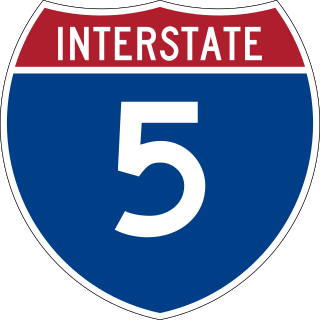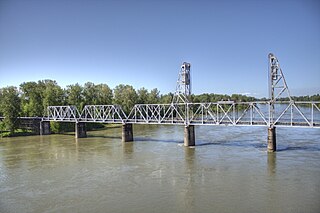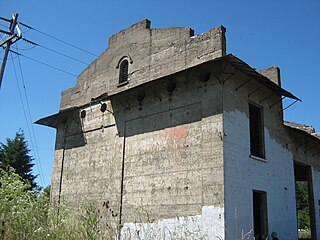Related Research Articles

Interstate 5 (I-5) is the main north–south Interstate Highway on the West Coast of the United States, running largely parallel to the Pacific Coast of the contiguous U.S. from Mexico to Canada. It travels through the states of California, Oregon, and Washington, serving several large cities on the West Coast, including San Diego, Los Angeles, Sacramento, Portland, and Seattle. It is the only continuous Interstate highway to touch both the Mexican and Canadian borders. Upon crossing the Mexican border at its southern terminus, the highway continues to Tijuana, Baja California, as Mexican Federal Highway 1 (Fed. 1). Upon crossing the Canadian border at its northern terminus, it continues to Vancouver as British Columbia Highway 99 (BC 99).

Dallas is a city and the county seat of Polk County, Oregon, United States. The population was 16,854 at the 2020 census.
Brooklyn is a mostly residential neighborhood in southeast Portland, Oregon. It sits along the east side of the Willamette River in the vicinity of Reed College. Founded as a neighborhood in the late 1860s, the neighborhood today is a middle-class area comprising mainly single family homes, interspersed with remaining industrial sites along the river and a large railyard. This railyard was home to Southern Pacific 4449 as well as several other large antique steam and diesel-electric locomotives.

The Portland and Western Railroad is a 516-mile (830 km) Class II railroad serving the U.S. state of Oregon, and is a wholly owned subsidiary of shortline and regional railroad holding company Genesee & Wyoming Inc. The PNWR includes a subsidiary, the Willamette and Pacific Railroad.

The Willamette Valley Railway is a short-line railroad that operates in the Willamette Valley of Oregon. It leased a line from Woodburn to Stayton from the Southern Pacific Transportation Company in February 1993, as well as a branch from Geer west to Salem, and purchased the property in 1996. The company also leased a line between Albany and Mill City in 1993, but transferred the lease to the Albany and Eastern Railroad in October 2000.
Willamette Industries, Inc. was a Fortune 500 forest products company based in Portland, Oregon, United States. In 2002, the lumber and paper company was purchased by competitor Weyerhaeuser of Federal Way, Washington in a hostile buyout and merged into Weyerhaeuser's existing operations.
Historic ferries in Oregon are water transport ferries that operated in Oregon Country, Oregon Territory, and the state of Oregon, United States. These ferries allowed people to cross bodies of water, mainly rivers such as the Willamette in the Willamette Valley, and the Columbia, in order to transport goods, move people, and further communications until permanent bridges were built to allow faster crossing of the water. The early ferries were used by wagons and pedestrians, while later ones transported trains and then automobiles. Oregon has a few automobile ferries still in operation.
Gerlinger is a surname. Notable people with the surname include:
Louis Gerlinger Sr. was a businessperson in the railroad and timber industries in the U.S. state of Oregon in the early 20th century.
George T. Gerlinger was influential in the railroad and lumber products business in the U.S. state of Oregon in the early 20th century. The oldest son of Louis Gerlinger, Sr., in 1902 he organized a group of investors in Dallas, Oregon to build railroad lines in the area.

Willamette Iron Works was a general foundry and machine business established in 1865 in Portland, Oregon, originally specializing in the manufacture of steamboat boilers and engines. In 1904, the company changed its name to Willamette Iron and Steel Works, under which name it operated continually until its close in 1990.

The Union Street Railroad Bridge is a vertical lift, Pratt through truss bridge that spans the Willamette River in Salem, Oregon, United States, built in 1912–13. It was last used by trains in the early 1990s and was sold for one dollar in 2003 to the City of Salem, which converted it to bicycle and pedestrian use in 2008–2009. It was added to the National Register of Historic Places in 2006.

Charles Bruce Moores was an American businessman and politician in the state of Oregon. A native of Missouri, he came from a family of politicians including his father John H. Moores, his grandfather Isaac R. Moores, and uncle Isaac R. Moores, Jr. who all served in the Oregon Legislature. A Republican, he served as the Speaker of the Oregon House of Representatives during his sole term in the House in 1895.

Waconda is an historic unincorporated community in Marion County, Oregon, United States, near the crossroads of River Road and Waconda Road. Waconda was once a station on the Oregon Electric Railway and formerly had a post office by the same name.

The Valley and Siletz Railroad (VS) is a 40.6-mile (65.3 km) defunct railroad located in Polk and Benton counties in the U.S. state of Oregon.

Waddell & Harrington was an American engineering company that designed bridges from 1907 to 1915. It was formed in 1907 as a partnership of John Alexander Low Waddell (1854–1938) and John Lyle Harrington (1868–1942) and was based in Kansas City, Missouri, but had offices in Portland, Oregon, and Vancouver, British Columbia. The company designed more than 30 vertical-lift bridges for highways and railroads.
Black Rock is an unincorporated community and former logging camp in Polk County, Oregon, United States. It is located about three miles west of Falls City, in the Central Oregon Coast Range on the Little Luckiamute River.

Elwood was a sternwheel steamboat which was built to operate on the Willamette River, in Oregon, but which later operated on the Lewis River in Washington, the Stikine River in Canada, and on Puget Sound. The name of this vessel is sometimes seen spelled "Ellwood". Elwood is probably best known for an incident in 1893, when it was approaching the Madison Street Bridge over the Willamette River in Portland, Oregon. The bridge swung open to allow the steamer to pass. However, a streetcar coming in from the east end of the bridge failed to notice the bridge was open, and ran off into the river in the Madison Street Bridge disaster.
The Salem, Falls City and Western Railway (SFC&W) was an American railroad based in Polk County, Oregon that ran between Salem and Black Rock via Dallas and Falls City.

Relief was a stern-wheel steamboat that operated on the Columbia and Willamette rivers and their tributaries from 1906 to 1931. Relief had been originally built in 1902, on the Columbia at Blalock, Oregon, in Gilliam County, and launched and operated as Columbia, a much smaller vessel. Relief was used primarily as a freight carrier, first for about ten years in the Inland Empire region of Oregon and Washington, hauling wheat and fruit, and after that was operated on the lower Columbia river.
References
- 1 2 3 Starner, D Earl. A Pictorial History of the Straddle Carrier. Lowell, Oregon: Vidagraph Publications. 1988. 48p.
- ↑ Baldwin, Cathrine A. Making the Most of the Best: Willamette Industries' Seventy-Five Years. Portland, Oregon: Willamette Industries. 1982. 172p.OCLC 8734832
- ↑ Rohde; Meaghers, Sue Hunter; Debra Lea (2012). Dallas. Ardacia Publishing. p. 51. ISBN 978-0-7385-9622-8.
{{cite book}}: CS1 maint: multiple names: authors list (link) - 1 2 LLC, Cuffe Sohn Design. "About Gerlinger Straddle Carrier". www.gerlingercarrier.com. Retrieved 2018-01-24.
- ↑ "Business Registry Business Name Search". egov.sos.state.or.us. Retrieved 2018-01-24.